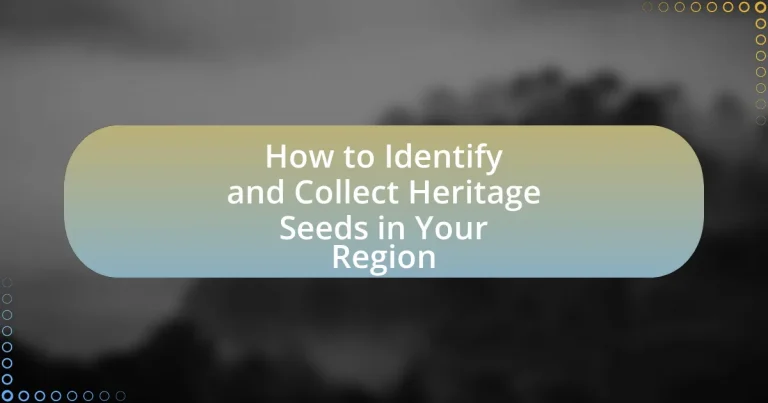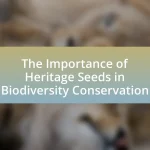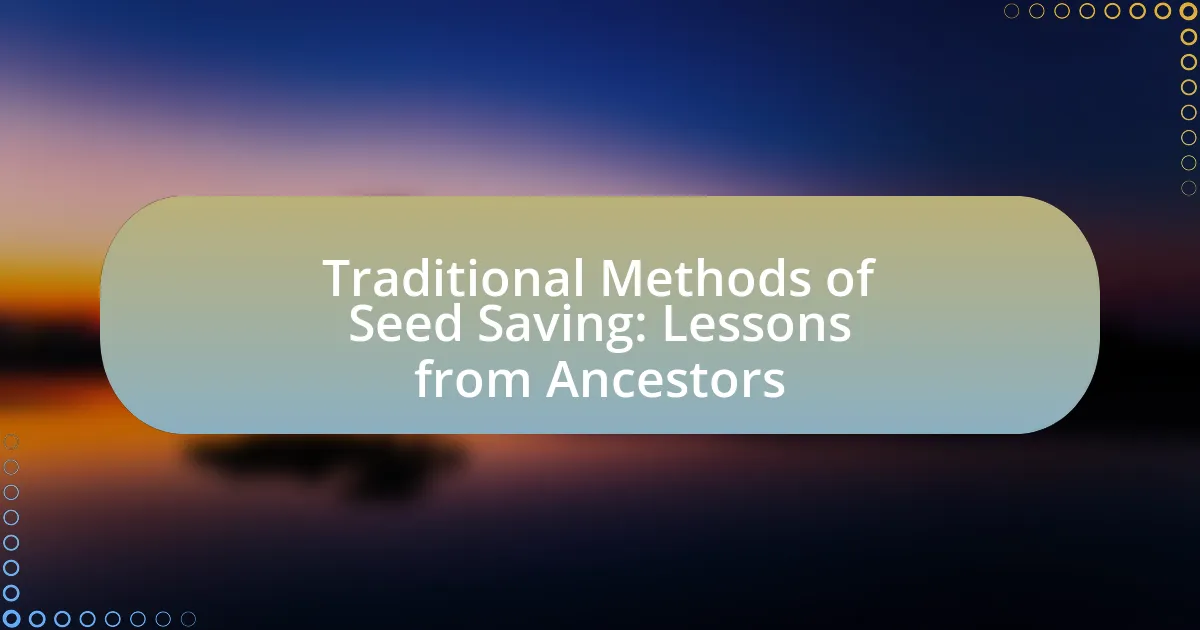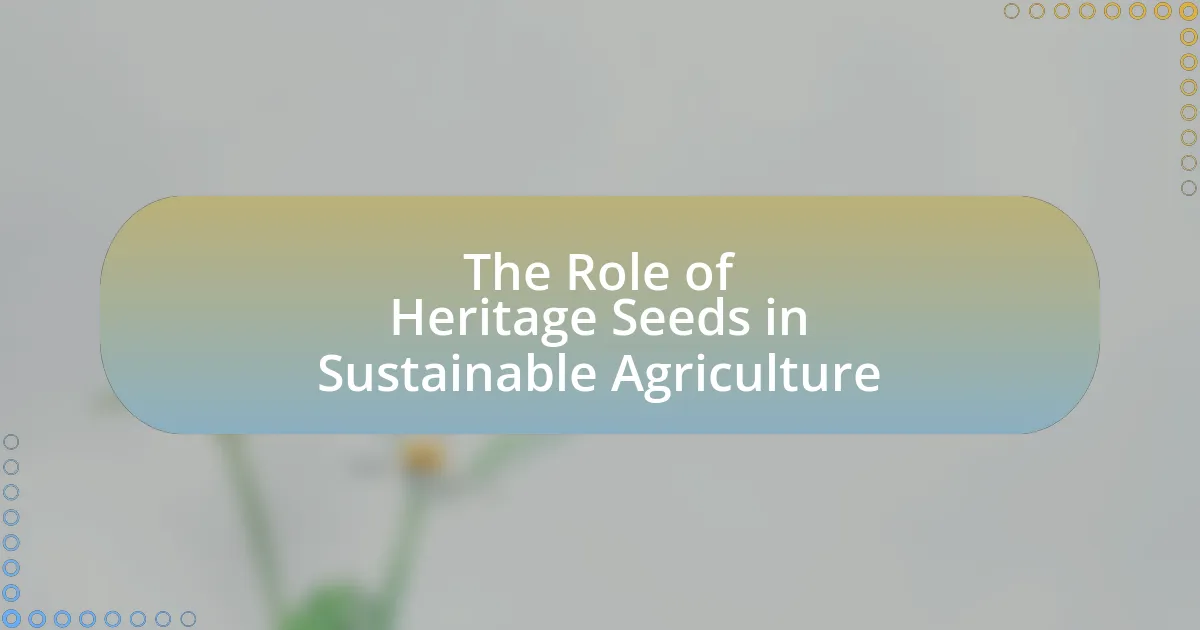Heritage seeds are traditional, open-pollinated varieties that have been cultivated over generations, playing a crucial role in preserving genetic diversity and enhancing food security. This article outlines the importance of heritage seeds, their differences from hybrid and GMO seeds, and their unique characteristics. It provides guidance on identifying, collecting, and preserving heritage seeds, as well as best practices for growing them successfully. Additionally, it highlights the resources available for gardeners and farmers interested in maintaining these valuable seed varieties, emphasizing their significance in local ecosystems and agricultural sustainability.

What are Heritage Seeds and Why are They Important?
Heritage seeds are traditional varieties of seeds that have been passed down through generations, often cultivated by local farmers and gardeners. These seeds are important because they preserve genetic diversity, which is crucial for food security and resilience against pests and diseases. According to the Food and Agriculture Organization, over 75% of crop diversity has been lost in the last century, making heritage seeds vital for maintaining a diverse agricultural ecosystem. Additionally, heritage seeds often have unique flavors and characteristics that are well-suited to local growing conditions, contributing to sustainable agriculture and cultural heritage.
How do Heritage Seeds differ from Hybrid and GMO Seeds?
Heritage seeds differ from hybrid and GMO seeds primarily in their breeding methods and genetic stability. Heritage seeds are open-pollinated varieties that have been passed down through generations, maintaining their genetic traits over time, while hybrid seeds result from controlled cross-breeding of different plant varieties to produce specific traits, and GMO seeds are genetically modified through biotechnology to introduce new traits. Heritage seeds can be saved and replanted year after year, preserving their characteristics, whereas hybrid seeds often do not produce offspring with the same traits, and GMO seeds are subject to patent restrictions and regulatory oversight. This distinction is crucial for gardeners and farmers interested in biodiversity and sustainable practices.
What characteristics define Heritage Seeds?
Heritage seeds are defined by their open-pollinated nature, historical significance, and genetic diversity. These seeds have been passed down through generations, often for at least 50 years, and are valued for their ability to produce plants that retain the same characteristics as the parent plants. Heritage seeds are typically non-hybrid, meaning they can be saved and replanted without losing their traits, which promotes biodiversity and sustainability in agriculture. Additionally, they often exhibit resilience to local growing conditions, making them well-suited for specific regions.
Why should gardeners choose Heritage Seeds over other types?
Gardeners should choose Heritage Seeds because they offer genetic diversity, adaptability to local conditions, and superior flavor compared to hybrid or genetically modified seeds. Heritage Seeds are open-pollinated, meaning they can be saved and replanted year after year, promoting sustainable gardening practices. Additionally, these seeds often have a rich history and are well-suited to specific regional climates, enhancing their resilience and productivity. Studies have shown that crops grown from Heritage Seeds can outperform hybrids in taste and nutritional value, making them a preferred choice for many gardeners.
What role do Heritage Seeds play in biodiversity?
Heritage seeds play a crucial role in biodiversity by preserving genetic diversity within plant species. These seeds are derived from traditional varieties that have been cultivated over generations, often adapted to local climates and conditions. By maintaining a wide range of genetic traits, heritage seeds contribute to ecosystem resilience, enabling plants to withstand pests, diseases, and changing environmental conditions. Studies indicate that the use of heritage seeds can enhance agricultural biodiversity, which is essential for food security and sustainable farming practices. For instance, the Seed Savers Exchange reports that heritage varieties can contain unique traits that modern hybrids lack, thereby supporting a diverse agricultural landscape.
How do Heritage Seeds contribute to local ecosystems?
Heritage seeds contribute to local ecosystems by promoting biodiversity and enhancing soil health. These seeds are often well-adapted to local climates and conditions, which allows them to thrive without the need for synthetic fertilizers or pesticides. Research indicates that diverse plant varieties can improve ecosystem resilience, as seen in studies showing that increased genetic diversity leads to better pest resistance and disease management. Additionally, heritage seeds support local wildlife by providing food and habitat, thereby fostering a balanced ecosystem.
What are the implications of losing Heritage Seeds?
Losing heritage seeds has significant implications for biodiversity, food security, and cultural heritage. The extinction of these seeds reduces genetic diversity in crops, making agricultural systems more vulnerable to pests, diseases, and climate change. For instance, a study by the Food and Agriculture Organization (FAO) indicates that 75% of crop diversity has been lost since the 1900s, which threatens the resilience of food systems globally. Additionally, heritage seeds often carry unique traits that are adapted to local environments, and their loss can lead to a reliance on a limited number of commercial seed varieties, which may not be suitable for all regions. This shift can undermine traditional farming practices and diminish the cultural significance associated with local agricultural heritage.

How can you identify Heritage Seeds in your region?
To identify Heritage Seeds in your region, research local seed catalogs and agricultural extension services that specialize in heirloom varieties. Heritage Seeds are typically open-pollinated, non-hybrid seeds that have been passed down through generations, often adapted to local growing conditions. You can verify their heritage status by checking for specific traits such as unique flavors, colors, and growth habits that are characteristic of traditional varieties. Additionally, organizations like Seed Savers Exchange provide resources and databases to help identify and locate Heritage Seeds specific to your area.
What are the key features to look for in Heritage Seeds?
Key features to look for in Heritage Seeds include genetic diversity, open-pollination, and historical significance. Genetic diversity ensures resilience against pests and diseases, allowing plants to adapt to changing environmental conditions. Open-pollination means that seeds can be naturally pollinated by insects or wind, preserving their unique traits over generations. Historical significance refers to seeds that have been passed down through generations, often linked to specific regions or cultures, which can enhance biodiversity and preserve agricultural heritage. These features collectively contribute to the sustainability and ecological value of heritage seeds.
How can you recognize the unique traits of local Heritage Seeds?
Local Heritage Seeds can be recognized by their distinct characteristics such as unique flavor profiles, adaptability to local climates, and historical significance tied to specific regions. These seeds often exhibit traits like irregular shapes, varied colors, and resistance to local pests, which have been preserved through generations of cultivation. For example, heirloom tomatoes may display a range of colors and sizes, reflecting their diverse genetic backgrounds. Additionally, local heritage seeds are typically open-pollinated, meaning they can reproduce true to type, ensuring that the traits are passed down in subsequent generations. This preservation of genetic diversity is crucial for maintaining agricultural resilience and food security.
What resources are available for identifying Heritage Seeds?
Resources available for identifying Heritage Seeds include seed catalogs, online databases, and local seed banks. Seed catalogs, such as those from Seed Savers Exchange, provide detailed descriptions and historical information about various heritage seed varieties. Online databases like the USDA’s Plant Database offer searchable information on plant species, including heritage varieties. Local seed banks often have knowledgeable staff and community resources that can assist in identifying and sourcing heritage seeds specific to your region. These resources collectively support the preservation and understanding of heritage seeds, ensuring access to diverse plant genetics.
Where can you find Heritage Seeds in your area?
Heritage seeds can be found at local farmers’ markets, specialty garden centers, and seed exchanges in your area. Many farmers’ markets feature vendors who specialize in heirloom and heritage varieties, providing a direct source for these seeds. Additionally, local garden centers often carry a selection of heritage seeds, especially during planting seasons. Seed exchanges, which may be organized by community gardening groups or agricultural organizations, also serve as valuable resources for obtaining heritage seeds, allowing gardeners to trade and share unique varieties.
What local organizations or farms specialize in Heritage Seeds?
Local organizations and farms that specialize in Heritage Seeds include Seed Savers Exchange, which is a nonprofit organization dedicated to preserving heirloom seeds, and various community-supported agriculture (CSA) farms that focus on heritage varieties. Seed Savers Exchange has over 25,000 varieties of heirloom seeds in its collection, making it a key resource for those interested in heritage seeds. Additionally, many local farmers’ markets feature vendors who offer heritage seeds, promoting biodiversity and traditional farming practices.
How can seed swaps and community events help in finding Heritage Seeds?
Seed swaps and community events facilitate the discovery of Heritage Seeds by connecting individuals who share a common interest in preserving traditional plant varieties. These gatherings create a platform for gardeners and farmers to exchange seeds, often including rare or heirloom varieties that may not be available through commercial sources. For instance, a study by the Seed Savers Exchange indicates that community seed exchanges have successfully preserved over 25,000 varieties of heirloom seeds, showcasing the effectiveness of these events in maintaining genetic diversity. Additionally, participants often share knowledge about cultivation practices and local adaptations, further enhancing the chances of finding and successfully growing Heritage Seeds in specific regions.

What are the best practices for collecting Heritage Seeds?
The best practices for collecting heritage seeds include selecting mature seeds from healthy plants, ensuring genetic diversity, and properly storing seeds. Collecting seeds from fully ripe fruits or pods maximizes viability, as immature seeds may not germinate effectively. Maintaining genetic diversity is crucial; therefore, gather seeds from multiple plants within a variety to preserve unique traits. Proper storage in a cool, dry, and dark environment prevents seed degradation and extends longevity. These practices are supported by agricultural studies indicating that seed viability decreases significantly when seeds are not harvested at the right time or stored improperly.
How should you prepare for seed collection?
To prepare for seed collection, first gather the necessary tools, including clean containers, labels, and a notebook for recording details. This preparation ensures that seeds are collected and stored properly, minimizing contamination and loss. Additionally, research the specific plants you intend to collect seeds from, as understanding their growth cycles and optimal harvesting times is crucial for successful seed collection. For example, many plants produce seeds when they are fully mature, which is typically indicated by changes in color or texture. Proper timing and knowledge of the plants increase the likelihood of obtaining viable seeds.
What tools and materials do you need for collecting seeds?
To collect seeds, you need tools such as scissors or pruners, seed envelopes or containers, and a notebook for documentation. Scissors or pruners are essential for cutting seed heads or pods from plants without damaging them. Seed envelopes or containers are necessary for safely storing the collected seeds and preventing moisture damage. A notebook is important for recording details about the seeds, including the plant species, collection date, and location, which aids in proper identification and future planting. These tools facilitate an organized and effective seed collection process.
What is the best time of year to collect Heritage Seeds?
The best time of year to collect Heritage Seeds is during the late summer to early fall, specifically from August to October. This period is optimal because seeds are typically fully mature and dry, which enhances their viability for future planting. Collecting seeds at this time ensures that they have developed properly on the plant, as seeds harvested too early may not germinate effectively.
What techniques can you use for successful seed collection?
Successful seed collection techniques include selecting the right time for harvesting, ensuring proper plant identification, and using appropriate tools for collection. Harvest seeds when they are fully mature, typically when seed pods or heads have dried but before they disperse naturally. Accurate plant identification is crucial to ensure the seeds collected are from the desired heritage varieties. Tools such as scissors, paper bags, and envelopes facilitate careful collection and storage, preventing damage to seeds. Research indicates that proper timing and technique can significantly enhance seed viability, with studies showing that seeds collected at optimal maturity have higher germination rates.
How do you ensure the seeds are viable and healthy?
To ensure seeds are viable and healthy, conduct a germination test by placing a sample of seeds on a damp paper towel and observing their sprouting over a specified period, typically 7 to 14 days. This method allows you to assess the percentage of seeds that germinate, indicating their viability. Additionally, store seeds in a cool, dry place to prevent mold and decay, as proper storage conditions significantly enhance seed longevity and health. Research shows that seeds stored at lower temperatures and humidity levels maintain higher viability rates, with studies indicating that seeds can remain viable for years when stored correctly.
What methods can you use to store collected seeds properly?
To store collected seeds properly, use methods such as drying, sealing in airtight containers, and refrigeration. Drying seeds reduces moisture content, which prevents mold and decay; seeds should be spread out in a single layer in a cool, dark place until fully dry. Once dried, sealing seeds in airtight containers, such as glass jars or vacuum-sealed bags, protects them from moisture and pests. Refrigeration further extends seed viability by maintaining a stable, cool temperature, which slows down metabolic processes. Research indicates that seeds stored under these conditions can remain viable for several years, with some types lasting even decades when properly managed.

How can you preserve and propagate Heritage Seeds?
To preserve and propagate heritage seeds, store them in a cool, dry place and ensure they are kept in airtight containers to prevent moisture and pests. Heritage seeds can be propagated by planting them in nutrient-rich soil, ensuring proper spacing, and providing adequate water and sunlight. Research indicates that heritage seeds, which are open-pollinated and non-hybrid, can be saved and replanted year after year, maintaining their genetic diversity and adaptability. This method has been practiced for generations, ensuring the preservation of unique plant varieties that are often better suited to local growing conditions.
What are the best methods for preserving Heritage Seeds?
The best methods for preserving Heritage Seeds include proper storage, seed saving techniques, and maintaining genetic diversity. Proper storage involves keeping seeds in a cool, dark, and dry environment to prevent moisture and temperature fluctuations that can lead to seed degradation. Seed saving techniques, such as selecting seeds from the healthiest plants and allowing them to fully mature before harvest, ensure that the seeds retain their viability and genetic traits. Maintaining genetic diversity is crucial, as it helps protect against diseases and environmental changes, which can be achieved by growing a variety of heritage seed types in different locations. These methods are supported by agricultural studies that emphasize the importance of seed preservation for biodiversity and food security.
How can you maintain seed purity during propagation?
To maintain seed purity during propagation, implement isolation techniques such as physical barriers or distance between different plant varieties. These methods prevent cross-pollination, which can lead to genetic contamination. For example, maintaining a minimum distance of 1,000 feet between different varieties of the same species is often recommended to ensure purity. Additionally, using controlled pollination methods, such as hand pollination, can further safeguard against unintended genetic mixing. These practices are supported by agricultural studies that emphasize the importance of isolation in preserving seed integrity.
What are the common challenges in preserving Heritage Seeds?
Common challenges in preserving heritage seeds include genetic erosion, loss of traditional farming practices, and inadequate funding for conservation efforts. Genetic erosion occurs when diverse seed varieties are replaced by a few commercial hybrids, reducing biodiversity. The loss of traditional farming practices, often due to modernization and industrial agriculture, leads to a decline in the cultivation of heritage seeds. Additionally, inadequate funding hampers research and conservation programs, making it difficult to maintain seed banks and educate farmers about the importance of heritage seeds. These factors collectively threaten the sustainability and availability of heritage seed varieties.
What tips can help you successfully grow Heritage Seeds?
To successfully grow Heritage Seeds, ensure you select varieties suited to your local climate and soil conditions. Heritage Seeds thrive when planted in well-drained, nutrient-rich soil, ideally amended with organic matter such as compost. Additionally, practice crop rotation to maintain soil health and reduce pest buildup, as this method has been shown to enhance biodiversity and yield. Regular watering, particularly during dry spells, is crucial, as consistent moisture supports seed germination and plant growth. Furthermore, protecting plants from pests and diseases through natural methods, such as companion planting, can lead to healthier crops. Research indicates that these practices not only improve the success rate of growing Heritage Seeds but also contribute to sustainable gardening.
How do you create the ideal growing conditions for Heritage Seeds?
To create the ideal growing conditions for Heritage Seeds, ensure they are planted in nutrient-rich, well-draining soil with a pH level between 6.0 and 7.0. Heritage Seeds thrive in full sunlight, requiring at least six hours of direct sunlight daily, which promotes healthy growth and fruit production. Additionally, maintaining consistent moisture without waterlogging is crucial, as it supports seed germination and root development. Research indicates that organic matter, such as compost, enhances soil fertility and structure, benefiting Heritage Seeds by providing essential nutrients and improving moisture retention.
What are the common pests and diseases to watch for with Heritage Seeds?
Common pests and diseases to watch for with Heritage Seeds include aphids, whiteflies, and powdery mildew. Aphids can cause significant damage by sucking sap from plants, leading to stunted growth and reduced yields. Whiteflies also feed on plant sap and can transmit viral diseases, further harming the plants. Powdery mildew is a fungal disease that manifests as a white powdery coating on leaves, which can hinder photosynthesis and weaken the plant. Monitoring for these pests and diseases is crucial for maintaining the health and productivity of Heritage Seeds.
What resources are available for further learning about Heritage Seeds?
Resources for further learning about Heritage Seeds include books, online courses, and agricultural organizations. Notable books such as “Seed to Seed” by Suzanne Ashworth provide comprehensive information on seed saving and heritage varieties. Online platforms like the Seed Savers Exchange offer webinars and articles focused on heritage seeds. Additionally, organizations such as the USDA and local agricultural extension services provide educational materials and workshops on the importance and cultivation of heritage seeds. These resources collectively enhance understanding and practical knowledge regarding heritage seeds.





